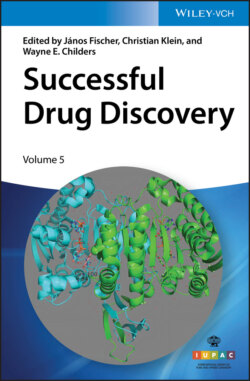Читать книгу Successful Drug Discovery, Volume 5 - Группа авторов - Страница 31
1.6.2 Acyclic Nucleoside Phosphonates
ОглавлениеViral infections remain among the deadliest and most difficult to treat diseases. Influenza, herpes, smallpox, acquired immune deficiency syndrome (AIDS), and, more recently, COVID‐19 developed into major health concerns for the global population. In the late 1950s, Yale scientist William Prusoff developed idoxuridine (Figure 1.13) [110] originally profiled for antibacterial and anticancer properties; it turned to be the first approved antiviral agent (1962). However, cardiac toxicity prevents its systemic application. This iodinated thymidine analogue can effectively inhibit the replication of various DNA viruses. In order to be activated, it needs to be converted to the corresponding triphosphate and can then be incorporated into viral, but also host cellular DNA. The modified DNA demonstrates higher susceptibility to erroneous transcription and strain breakage.
In 1976, Erik De Clercq (Rega Institute for Medical Research, Catholic University of Leuven, Belgium), a Belgian physician and virologist, and Antonín Holý, a Czech chemist (Czechoslowak Academy of Science, Prague) met at a symposium on synthetic nucleosides organized by the Max Planck Society and subsequently started a very successful collaboration [111]. At the time, Hóly was one of the most important chemists in Eastern Europe, De Clercq was an enthusiastic 35‐year‐old physician. In the course of this collaboration, they developed a deep and trusting relationship. Working on synthetic nucleoside analogues, they quickly discovered (S)‐9‐(2,3‐dihydroxypropyl)adenine ((S)‐DHPA, Figure 1.15), the first acyclic nucleoside analogue [112] that displayed broad antiviral activity. Stimulated by reports on antiviral activities of simple phosphonates like phosphonoacetic acid, they set out to develop bioisosteric catabolically stable nucleotide analogues. Adding a phosphonate to the primary hydroxyl group led to the active monophosphate analogue, (S)-(3-hydroxy-2-phosphonylmethoxypropyl)adenine ((S)‐HPMPA) (Figure 1.15) [113]. This compound displayed encouraging activity against various DNA viruses and seemed to work through a different mechanism than acyclovir, which had been described shortly before. They also discovered that the corresponding cytosine derivative ((S)‐HPMPC, Figure 1.15) possessed an antiviral spectrum comparable to that of HPMPA [114]. This compound was later approved as cidofovir. Structural simplification of (S)‐HPMPA, in particular removing the stereogenic center, led to adefovir, which was approved for treatment of hepatitis B in September 2002. Further optimization led to tenofovir, which, despite its chemical similarity, is more specific than adefovir (Figure 1.15) and does not inhibit herpesviridae. It is approved for treatment of human immunodeficiency virus (HIV), both alone and as combination therapy with emtricitabin, sold under the brand name Truvada™.
Figure 1.15 Structures of antiviral compounds developed by Hóly and De Clercq.
Tenofovir (Figure 1.15) is a prodrug that is quickly deprotected intracellularly, followed by double phosphorylation by adenosine monophosphate (AMP) kinase. The resulting triphosphate analogue cannot undergo complete dephosphorylation due to the presence of the phosphonate. Also, in contrast to other nucleotide drugs not bearing a phosphonate group (e.g. acyclovir), the activity of tenofovir does not rely on initial phosphorylation by viral kinases. It should thus possess a broad activity. It selectively inhibits the viral enzyme reverse transcriptase and displays favorable selectivity against human DNA polymerases. These compounds were originally synthesized by Hóly in the form of their free phosphonates and displayed minimal bioavailability. Only when prodrug forms were developed [115] could the compounds be quickly absorbed after oral dosing.
After the original compounds within this class were discovered in the 1980s, preclinical exploration of several derivatives was performed at Bristol‐Meyers. Upon merging with Squibb, the new company stopped projects involving these compounds, and the compound rights were returned to the inventing universities. Development of this compound class was reinitiated in 1989 by Gilead, leading to successful approval of three different new chemical entities (NCEs). In a license agreement, Gilead agreed to pay €11 million to the two universities, along with another 3% to 5% of net sales of different licensed products. Annual royalties to the Institute of Organic Chemistry and Biochemistry reached up to €90 million per year. Furthermore, in 2006 Gilead agreed to donate €1.1 million to create and sustain a Gilead Sciences Research Centre on campus. Hóly retired in 2011 and died on 16 July 16 2012, just two months after tenofovir was approved for treatment of HIV. On the very same day of Hóly's passing away, Truvada was also approved for prevention of HIV infections.
